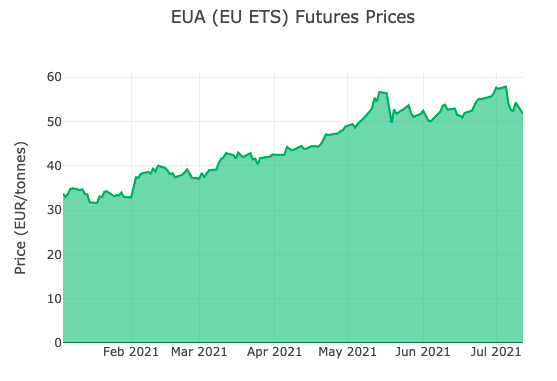Green Energy: Could carbon credits be the next boom market?
Energy
Energy
Forget copper and iron ore, could planting trees and storing carbon be the next boom market?
Carbon prices in the EU’s long established Emissions Trading Scheme have sailed through the roof in 2021 as investor pressure grows and emissions reductions targets gain increased corporate traction.
The price of carbon has soared to records not seen since the launch of the market in 2005 of over 50 euros a tonne, with some especially above-consensus analysts predicting it could climb as high as 110 euros by the end of the year.

Australian Carbon Credit Units have reached $20.25/t, rising an impressive 23% year to date and 28% over the past 12 months.
According to Reputex Energy, which last week published its carbon market outlook for 2021-2030, they could fetch upwards of $50-60/t by 2030 as the market matures.
Australia is a little different from Europe in that it is not a compliance market, thanks to changes to carbon pricing dating back to Tony Abbott’s successful 2013 election campaign against the Gillard Labor Government’s carbon price.
But Reputex Energy executive director Hugh Grossman said investor pressure and corporate interest is now driving prices for ACCUs.
“The reason prices are increasing is not due to government policy and more due to corporate demand increasing,” he said.
“Really for the first time we’re seeing investors and corporates driving the market rather than Government policy.
“It’s the first time we’ve seen prices at that level since 2014 under the carbon price mechanism, which obviously had a fixed price period that had prices a little bit higher than where we are today.”
The Clean Energy Regulator announced in April it was taking expressions of interest to operate an online carbon exchange, which is expected to be operational by 2023.
According to Grossman, this will provide investors with normal market features like liquidity, price discovery, transparency and the overlay of futures and derivatives.
“General access and transparency will be really supportive for the increased participation of investors in Australia,” he said.
At high uptake scenarios he expects investors to increase their share of long positions in the carbon market towards today’s levels of 33% in Europe by 2025 and 50% by 2030.
It will likely be less, but policy support could grow over the coming years because Australia’s net zero target (which is currently regarded as a 2050 ‘preference’ by Prime Minister Scott Morrison) is likely to be brought forward as moods shift in favour of the low carbon transition.
The value of ACCUs in investment portfolios will become more material as well.
“I think the real play for the Australian market will be when institutional investors and portfolio managers begin to use carbon as a hedging tool (against emissions intensive investments),” Grossman said.
“When that begins to occur we will ultimately see carbon become part of balanced portfolios in Australia.
“I think that will not be an immediate step but something we will see over the forecast period.”